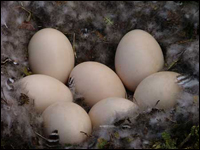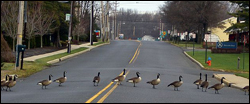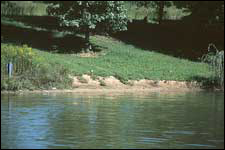What is the Fairfax County Geese Management Program?
Fairfax County has a growing population of year-round resident Canada geese. The increasing number of resident geese has lead to increased conflict and concern among human residents.
All available management tools are used in the Geese Management program:
Addling
Addling is an important tool to humanely reduce a goose population over time. Addling is a technique that prevents embryos from developing by coating eggs with 100% corn oil. The oil traps heat inside the egg. Eggs should be addled within 14 days of being laid in the nest.
Canada geese are a federally protected species under the Migratory Bird Treaty Act. A federal permit can be obtained online at no cost. (More information)

Geese Eggs
Landscape Modification
Identify and eliminate or minimize goose attractants in the immediate area:
- Water (pond, fountain, lake)
- Food sources (vegetation, turf grass)
- Nesting areas
Prevent easy access to bodies of water using barriers, grids, or other physical deterrents. Grassy areas can be landscaped with plants that provide physical and visual barriers to deter geese from entering the water. Railings can be installed along a pond or fountain and nearby walkways to provide barrier protection for plants.

Landscape Modification
Deterrence and Repellency
Canada geese are a federally protected species under the Migratory Bird Treaty Act. It is illegal to harm or kill these birds. Humane repellency methods such as dogs, lasers or other frightening techniques are recommended.
It is also recommended that residents do not feed Canada geese or other wildlife. Supplemental feeding can make geese dependent on humans, lead to greater aggression between geese, and increase the spread of wildlife transmitted diseases.
What concerns are associated with large populations of Canada geese?
Public Health
- Studies indicate there is some concern of the potential for disease transmissions from goose droppings to humans
- Goose droppings and molted feathers can litter public walkways and park benches
- Goose droppings can be tracked inside of homes and offices
Public Safety
- Geese crossing roads can interfere with traffic or cause goose-vehicle collisions
- Nesting geese can become aggressive and territorial. Injuries to humans by nesting geese are not common, but have been reported in Fairfax County.

Geese in the Road
Environmental Impact
- Geese damage vegetation along water shorelines and adjacent grassy areas. New vegetation growth is inhibited
- Bare spots lead to soil erosion and sedimentation of ponds and streams
- Water runoff carries away nutrient-rich droppings which causes algae growth and adverse effects on natural vegetation and aquatic life
- Geese can drive away or kill smaller waterfowl from ponds or waterways

Goose Damage